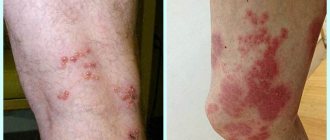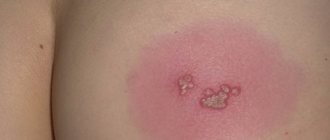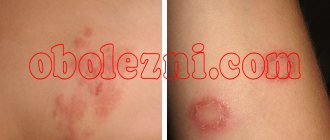Herpetic infections that affect children are quite diverse and are far from limited to the so-called cold sores. Moreover, it is in childhood that herpetic diseases most often occur, which the vast majority of adults do not even know about.
For example, the photo below shows the external manifestations of sudden exanthema (also known as roseola or pseudorubella) - a fairly common herpes infection, often found in children:
And here is herpetic panaritium, which is found in children more often than in adults:
In general, almost every child in the first few years of his life usually faces several infections caused by herpes viruses (many of which, fortunately, often do not make themselves felt at all in adulthood).
It is useful to keep in mind that the concepts of “herpes” and “herpetic infection” differ in their meaning. The word “herpes” usually refers to diseases caused by the herpes simplex viruses of the first and second types. In most cases, these are colds on the lips and genital herpes, less often - herpetic panaritium, ophthalmic herpes and some other diseases.
The concept of herpes infection implies infection of the body with a herpes virus of any type, and in terms of the number of manifestations, such diseases are much more numerous than even the “many faces” of herpes. Accordingly, treatment of herpes infection in each specific case may require completely different approaches, medications and sanitary regimes.
But first things first…
Causative agents of herpes infections and associated diseases
The whole variety of herpes infections is associated with 8 different herpes viruses:
- Herpes simplex virus type 1 is the most common. In children, this virus can cause colds on the lips, herpetic stomatitis, herpetic whitlow (ulcers on the fingers), “wrestling herpes”, herpetic keratoconjunctivitis, viral encephalitis and meningitis, herpetic esophagitis, eczema and sycosis;
- Herpes simplex virus type 2, the most common cause of genital herpes. In children, it often manifests itself as neonatal herpes, or as a disseminated infection. Herpes viruses types 1 and 2 are often also called herpes simplex viruses;
- Herpes virus type 3 causes the famous chickenpox in children. And in case of relapse it causes the so-called herpes zoster - more often in adults, but sometimes in children too;
- Herpes virus type 4, also called Epstein-Barr virus. It is associated with a rather little-known disease - infectious mononucleosis. It is little known, by the way, not because of the small number of cases of infection, but because in most cases it is mistaken for a cold and the correct diagnosis is not made. In addition, some cancers are associated with this virus;
- Herpes virus type 5, or cytomegalovirus. The infection associated with it is called cytomegalovirus. According to some experts, every person in the world is infected with this infection, but few people know about it due to the fact that in the vast majority of cases it does not manifest itself in any way in a persistent form;
- Herpes virus type 6, also known as roseolovirus. Causes the so-called “sixth disease”, better known as infantile roseola or sudden exanthema;
- Herpes virus type 7, almost identical to the previous one. It also sometimes causes exanthema, but in adults it is often associated with chronic fatigue syndrome;
- And finally, herpes virus type 8, which is rather poorly studied. It is believed to cause Kaposi's sarcoma.
Herpes simplex on a child's hand:
Relapses of some of the diseases caused by herpes viruses have such unique symptoms that sometimes patients consider them to be independent diseases. For example, shingles is caused by the same virus that causes chickenpox, but only in cases where the infection “dormant” in the body is able to be reactivated when the immune system is weakened.
The photo below shows an example of shingles in a child:
This is interesting: the widely known “herpetic” throat infection in children is not actually herpetic. It is called herpangina, but is not associated with either sore throat or herpes. This disease is caused by intestinal Coxsackie viruses, and it resembles a sore throat only in the form of a sore throat, and a characteristic rash similar to herpes. The photo below shows such a pseudoherpetic infection in a child’s throat. However, the herpes simplex virus type 1 sometimes causes herpetic stomatitis, which can also invade the tonsils, which leads to a sore throat.
Herpetic sore throat:
Any of the above infections can manifest in a child of almost any age: from the neonatal period to adolescence. However, as a rule, certain herpetic infections are characteristic of different ages:
- Newborn period and infancy - herpes of newborns when infected from the mother during childbirth, as well as sudden exanthema;
- Preschoolers - chicken pox and infectious mononucleosis;
- Children 8-12 years old - infectious mononucleosis, chickenpox, cytomegalovirus, labial herpes and herpetic stomatitis;
- Teenagers - labial herpes, herpetic panaritium.
Diseases such as, for example, shingles or genital herpes in children for various reasons occur relatively rarely (the latter, due to the specific nature of its spread, can occur in adolescents who begin sexual activity early).
It is useful to know the main symptoms that herpetic infections manifest themselves in in order to recognize the disease in time and not to stuff your child with medications for diseases with which such infections are often confused. We will talk about these symptoms in more detail below, but for now let’s look at how exactly the body is infected with herpes viruses...
Congenital herpes and its forms
Congenital herpes infection, more correctly called neonatal herpes, provokes one of three forms.
- Generalized form. The risk of a baby getting this form of herpetic infection reaches 50%. The following signs are observed - general weakness of the body, high temperature, symptoms of pneumonia, various pathologies with the liver and adrenal glands, frequent regurgitation, as well as signs of shortness of breath.
- Localized form. Two weeks after birth, you can notice pronounced herpes rashes in the baby. This form is characterized by skin lesions in different parts of the body, herpetic eruptions on the oral mucosa and ocular forms of herpetic infection.
- Amazing form. It affects the nervous system and causes serious diseases such as encephalitis and meningoencephalitis. May be accompanied by convulsions and cytosis.
How does a virus infect the body?
Herpes viruses vary significantly in their contagiousness and main routes of transmission. For example, herpes simplex viruses are transmitted by direct contact with fluid from papules (vesicles), while chickenpox and Epstein-Barr virus can be easily transmitted through airborne droplets.
After entering the patient’s body, viral particles, under favorable conditions, penetrate into the tissue cells of the host body. Here the protein shell of the virion opens, and nucleic acids with the genetic information of the virus rush to the cell’s replication apparatus.
If the genome of the virus is successfully integrated into the genetic material of a human cell, then the latter begins, together with the proteins it needs, to produce components of viral particles. From them, new virions are collected right inside the cells, which, when accumulated in large quantities, lead to the death and destruction of the cell. In this case, the particles themselves are released, enter the blood, lymph, or simply the intercellular space, affect neighboring cells and spread further.
By the way, it is also useful to read:
- About herpes type 6 in children, the characteristics of the virus and the treatment of the disease it causes
- About herpes sore throat in children: from symptoms to treatment
Depending on the type of herpesvirus, its further existence in the body varies:
- When infected with herpes simplex viruses, some of the new virions cause skin lesions (most often on the lips), and some penetrate the nerve cells of the spinal cord, in which the DNA of the virus will remain in the future for the rest of a person’s life;
- When infected with chickenpox viruses and herpes virus type 6, virions quickly spread throughout the body and a rash appears on all parts of the body. In this case, again, the nervous tissue is affected, in which the virus can persist until the death of the host;
- The Epstein-Barr virus is tropic to the lymphocytes of the host's immune system, and it does not destroy them, but stimulates further proliferation;
- Cytomegalovirus in the host body infects the salivary glands in the largest quantities.
The photo shows chickenpox, one of the most common herpetic infections in children:
In most cases, primary herpetic infection is acute and without consequences. This is especially true for sudden exanthema, cytomegalovirus infection and infectious mononucleosis caused by the Epstein-Barr virus.
However, herpes simplex viruses in newborns can cause severe conditions, and without treatment, such infections can lead to serious complications and even death.
It is important to understand that herpes infections are among the most common in the human population in general. With a high probability, every one-year-old child has already had one of them and will have several of them before he reaches adulthood. Therefore, such an infection should be treated as normal.
This is interesting: about 90% of the world's population is infected with herpes simplex viruses. 52% of children aged 5 years and 95% of adults in the United States are carriers of the Epstein-Barr virus. Almost 100% of the world's population is infected with cytomegalovirus, with more than half of people becoming infected in childhood. Almost 100% of children in the countries of the former USSR get chickenpox, despite the fact that today a vaccine against it has been developed and is available for use.
Those herpes virus particles that have penetrated nerve cells or lymphocytes remain in the body forever. Virions produced by these cells are constantly released into the blood or into the intercellular space, where they are immediately destroyed by cells of the immune system. And only in the case of severely weakened immunity can they sometimes reach the corresponding tissues (for example, peripheral ones - say, the skin on the lips) and lead to re-infection of them with the development of a relapse of the disease.
This is interesting: in many children, relapses of herpetic diseases are mild and asymptomatic, which is why no one even suspects that these children are carriers of the virus and at certain periods of time can be sources of infection.
Herpes viruses have low interferonogenic activity, due to which, even when the infection is reactivated, the protective mechanisms in the child’s body are launched with a delay, as a result of which the virus has the opportunity to manifest itself, so to speak, fully.
Ways of infection with childhood herpes
The causes of herpes in children and the routes of transmission of the virus do not differ from the methods of viral cells entering the adult body, except for intrauterine infection or infection of a child during childbirth. There are five ways to transmit herpesvirus to children:
- By airborne droplets. Herpes in children often occurs due to the fact that close people who have a latent form of herpetic infection surround the baby. When sneezing or the free release of herpes cells from mucous membranes, it can spread through the air.
- Household method or direct contact. When sharing household items, the virus is transmitted through household items. And also during relapses of the disease, direct contact of an infected person with a healthy person provokes the herpes virus to penetrate a new body.
- Blood transfusion, organ transplantation. If a child undergoes complex operations such as organ transplantation, there is a high probability that an infected element will be transplanted. A more common medical procedure is to infect a child through a blood transfusion.
- Vertical route of transmission (perinatal). In this case, the virus enters the child while the baby is passing through the birth canal. Very often, herpes virus type 6 is transmitted in this way.
- Transplacental - through the placenta. When a pregnant woman does not have antibodies to any virus in her blood and becomes infected during pregnancy, the herpes virus can penetrate the placenta, and the child will already be born infected.
Despite the fact that there are five ways of contracting herpes in children, the most common cause of infection in a child is the baby’s mother. When a small child is surrounded by the care of his mother, and she often kisses him, or licks the spoon and pacifier, the herpes of the infected mother quickly enters the child's body. Initially, it causes herpetic stomatitis in a child under one year old, and then begins to recur in different areas of the skin. Relapses, as a rule, begin from the age of 5, when the immune response is formed. In children aged one to three years, relapses occur less frequently. But this applies to HSV.
Why are these infections essentially incurable?
A herpetic infection, once affecting the human body, remains in it forever. This is due to the localization of viral DNA in tissues that are extremely difficult or cannot be treated at all.
A good example is the herpes simplex viruses, as well as the varicella zoster virus. After infection, the initial manifestation of symptoms and suppression of the infection by the body's defenses, the genetic material of the virus is stored in the nuclei of nerve cells in the human body in the spinal cord.
Today, medicine does not have the means and methods that would make it possible to selectively remove foreign genetic material from the chromosomes of human nerve cells, or to replace the spinal cord nerve cells themselves with uninfected ones. This means that as long as such cells remain in the body, the virus is stored with them.
And, for example, the Epstein-Barr virus multiplies in lymphocytes - cells of the immune system itself, which, in principle, should fight virions. As in the previous case, it is extremely difficult to destroy all lymphocytes in the human body. And doing this just to get rid of a virus, which in the vast majority of cases does not cause serious illness, is irrational.
In addition, it is problematic to prevent infection of those cells from which it will be impossible to remove the virus in the future. For example, when infected with herpes simplex viruses, nerve cells are affected even before the characteristic rashes on the lips become noticeable, and the chickenpox virus is already firmly established in the spinal ganglia when the child just begins to develop a rash all over the body. Simply put, when parents realize that their baby has a herpetic disease, it is no longer possible to completely eliminate its pathogen from the body.
Fortunately, most herpes infections are not so dangerous that you should worry too much about their presence in the body.
Types of Herpes
There are several types of infection:
- HSV type 1 causes rashes on the lips, tongue and face;
- Type 2 - genital herpes. It is localized in the genitourinary system;
- Type 3 - chickenpox. Recurrence in adulthood - herpes zoster;
- herpes type 4 - Epstein-Barr virus - the cause of infectious mononucleosis;
- Type 5 - cytomegalovirus (causes several different infections);
- against the background of type 6 herpes, multiple sclerosis develops;
- Types 7 and 8 cause damage to the lymphatic system and oncology.
Dangerous consequences
In most cases, in healthy children, herpetic infections occur acutely, quickly and with virtually no consequences. The greatest danger is usually posed by herpes infection in a newborn child:
- Neonatal herpes, which a child becomes infected with during childbirth, or immediately before birth from a mother suffering from genital herpes. The consequences here can be the most severe - from eye damage to cerebral palsy and meningoencephalitis;
- Congenital cytomegalovirus infection, which in symptoms resembles infectious mononucleosis.
Herpes on the face of a newborn:
Also dangerous are oncological diseases, which in rare cases can be caused by the Epstein-Barr virus (Burkitt's lymphoma), cytomegalovirus and herpes virus type 8 (Kaposi's sarcoma).
All herpes virus infections are also dangerous for children with severely weakened immune systems. In them, even simple herpes can lead to damage to internal organs and a generalized disease with a severe course. This is also true for children undergoing therapy with artificial immunosuppression.
Note: in HIV-infected children, herpetic infections are one of the leading causes of death.
A healthy child who has picked up an infection already in kindergarten or school will most likely tolerate it quite easily, and only symptomatic treatment will be required from parents and a doctor to alleviate the severe manifestations of the disease.
The dangerous “consequences” of chickenpox are shingles and often associated postherpetic neuralgia, which occur less often and mainly in adults with weakened immune systems (the word “consequences” is in quotation marks, since chickenpox itself does not cause shingles - it can develop only when the infection is reactivated in the body).
Note: if you constantly scratch the blisters during chickenpox, scars may remain in their place for life. The bubbles themselves develop on the upper layers of the epidermis and after recovery disappear without a trace.
Diagnostics
Of all the herpetic infections in children, the least difficult is the diagnosis of chickenpox and herpes simplex viruses. It can be more difficult to determine the cause of the disease if it is caused by the Epstein-Barr virus, cytomegalovirus, or roseolovirus. Laboratory tests will be required for an accurate diagnosis. Typically used for these purposes:
- PCR (polymerase chain reaction) method. It allows you to detect viral DNA in various body fluids (for example, in a smear from the oral mucosa).
- ELISA (enzyme-linked immunosorbent assay). Shows the presence of antibodies to herpes in the child’s blood.
- RIF – immunofluorescence reaction. In this case, antibodies in the blood are “tinted” with a special substance, after which they can be easily detected and counted under a microscope.
Knowing exactly what pathogen caused the disease allows you to treat it more specifically and effectively. This information allows us to more accurately predict what complications can be expected in each case of the disease.
Symptoms and differential diagnosis of infections
Each herpes virus infection is characterized by a certain set of symptoms that allow an experienced doctor to diagnose it in a sick person. On the other hand, the clinical picture in most cases looks like that parents mistake some herpes diseases for colds and do not consult a doctor.
In general, the characteristic symptoms of herpetic infections are as follows:
- Diseases caused by herpes types 1 and 2 are usually accompanied by characteristic rashes in the form of transparent or yellowish-white blisters on a limited surface of the skin. The rashes themselves can appear almost anywhere: from the gums to the groin area, but most often they are localized on the lips (labial herpes), in the mouth (herpetic stomatitis) and on the fingers (herpetic whitlow). The rashes are painful, sometimes their appearance is accompanied by an increase in body temperature and general malaise;
- Chickenpox is characterized by a well-defined red rash over the entire body, as well as a feverish state;
- Infectious mononucleosis is asymptomatic in 85% of cases, and only sometimes causes a sore throat and runny nose, as well as swollen lymph nodes;
- Cytomegalovirus manifests itself mainly with generalized symptoms - signs of intoxication, chills, headaches and muscle pain;
- Herpetic infection type 6 in children (roseola) is characterized by a typical febrile state, after which the child develops a profuse rash all over the body.
Typical external symptoms of roseola are shown in the photo below:
Some diseases may have similar symptoms (for example, mononucleosis and cytomegalovirus infection), and some of them are so reminiscent of typical respiratory diseases that they are treated like flu or sore throat.
In many cases, to reliably diagnose a specific herpetic infection, it is necessary to take blood tests or undergo a special examination at a clinic.
How to treat herpes in children
To date, there are no methods or medications that could completely destroy viruses of this group in the body. Therefore, treatment of any herpes in children has the following goals:
- Prevent complications.
- Create favorable conditions for suppressing the virus using your own immune system.
- In severe cases, use special antiviral drugs to reduce the activity of the infection and transfer it to a latent state.
Since all herpes belong to the same group, their symptoms and treatment are largely similar. Medical recommendations for diseases of herpes etiology include bed rest, special nutrition and a number of medications (if necessary).
Mode
Herpes in children, as a rule, is accompanied by fever, lethargy and weakness - therefore, it is better for the patient to spend the acute period in bed. This is important when treating any herpetic infection in children. Under no circumstances should you attend kindergarten or school; walking and swimming should also be avoided for a while. It is important to create the most calm and friendly atmosphere possible so that the child can relax not only physically, but also psychologically.
As you recover, activity can gradually be increased (when the need arises). When the temperature normalizes, short walks are acceptable.
Diet
Nutrition plays one of the key roles in recovery. It should be both gentle and rich in nutrients. In the acute phase, when the child loses his appetite and often has difficulty swallowing, jelly and fruit drinks made from berries - cranberries, lingonberries, rose hips - will help. It is very important to maintain a drinking regime - the patient must receive enough fluid to combat intoxication of the body during a viral attack.
Nutritionists have identified a definite connection between the activity of herpes and food. Eating foods rich in lysine (an amino acid) has been shown to suppress viral infection:
- dairy products (kefir, fermented baked milk, milk, cheese, cottage cheese, yogurt);
- vegetables;
- pork, fish, chicken (white meat);
- legumes (lentils, soybeans).
Products contraindicated:
- peanut;
- raisin;
- chocolate;
- citrus fruit;
- nuts;
- some cereals.
They contain arginine, which stimulates the proliferation of herpes viruses and worsens the infection.
If herpes is diagnosed in a breastfed child under one year old, then the nursing mother needs to adhere to these dietary restrictions.
Drug treatment
There are no special medications for herpes for children. If necessary, the doctor may prescribe:
- Antipyretics if the temperature rises above 38-39 degrees.
- If the disease is accompanied by a rash (chickenpox), treatment with antiseptics will be required to prevent the development of a bacterial infection. For herpes sore throat, antiseptic solutions are used to gargle.
- Ointments for herpes (Acyclovir, Zovirax) can be prescribed to treat rashes caused by viruses of types 1 and 2.
- In case of severe intoxication, if there is a danger of damage to internal organs, hepatoprotectors are prescribed (Essentiale, Karsil).
- When the child’s body cannot cope with the infection, and there is a high risk of serious complications, the doctor may decide to prescribe antiviral drugs (these can be herpes pills - Ganciclovir, Acyclovir, Cytoven, or injections). In each case, the medicine and regimen of use are selected individually. This is an extreme measure, since this group of drugs is highly toxic. You cannot treat herpes in a child with such drugs without a doctor’s prescription.
- Complex therapy usually includes taking multivitamins. This helps strengthen the child’s own immunity.
- To speed up recovery, drugs from the interferon group (for example, Viferon suppositories) may be prescribed.
For any herpesvirus infection in children, treatment should be prescribed by a doctor. The selection of drugs is carried out taking into account the condition of the body, test results and the characteristics of the course of the disease. Before receiving prescriptions, the patient should be provided with rest, bed rest, and plenty of fluids.
Particular caution should be exercised in relation to folk remedies for herpes. The use of any herbal teas or lotions must be coordinated with your doctor, and in no case should they replace prescribed treatment. Contrary to the assurances of traditional healers, it is impossible to cure herpes completely - only to achieve stable remission.
Treatment of herpetic diseases in children
Treatment of herpetic infections is carried out in situations where the disease is too severe. At the same time, to treat most infections, specialized antiviral agents are used, first of all, and in addition to this therapy, symptomatic treatment agents are used.
Of the narrowly targeted drugs, it should be noted:
- When infected with herpes simplex viruses, as well as chickenpox - Acyclovir, Valacyclovir, Valtrex, Famvir and Famciclovir. Their use is not mandatory and, if used correctly, only allows to shorten the duration of the disease;
- When infected with the Epstein-Barr virus, symptomatic treatment is carried out - there are no specialized drugs against it;
- Treatment of cytomegalovirus infection is carried out with the help of antiviral agents - Ganciclovir, Foscarnet, Cidofovir, as well as with the use of specific immunoglobulin preparations - Cytotect, Megalotect and others;
- Sudden exanthema in children is not treated at all, or is treated with symptomatic therapy.
The use of interferon inducers and other immunomodulators for the treatment of herpetic infections is today not considered an effective and adequately safe method of therapy. In exceptional cases, such drugs can only be prescribed by a doctor and only under his personal responsibility.
Symptomatic treatment of herpetic infections involves the use of antipyretic and painkillers, and sometimes local hormonal ointments to reduce itching. By the way, the use of folk “green stuff” for both herpes and chickenpox has virtually no therapeutic effect.
Important! When you have chickenpox, aspirin cannot be used as an analgesic and antipyretic - this drug specifically for this infection can cause severe side effects on the liver.
As a rule, all herpetic infections resolve in children with normal immunity within 1-2 weeks. If the illness is prolonged or its symptoms are too severe, then the child should be shown to a doctor.
Treatment
Herpes in an infant is an indication for immediate hospitalization.
The administration of drugs is directed:
- to increase the body's resistance;
- to normalize the functions of the immune system;
- to reduce the activity of the infectious agent;
- to eliminate symptoms of the disease;
- to prevent complications.
During the treatment period it is not recommended to stop breastfeeding.
Is prevention possible?
To date, the chickenpox vaccine has passed all clinical trials and has been introduced into the vaccination calendars of the USA, Australia and Austria. According to research results, it provides reliable protection against infection with the virus, provides immunity for several years (after 20 years, the first vaccinated had 100% immunity and no one became infected with chickenpox) and is well tolerated, although it requires isolation of the child for several days immediately after vaccinations.
In Russia, vaccination against chickenpox is voluntary. The vaccine itself can be purchased at large pharmacies, although it is quite expensive.
There are currently no reliable vaccines for other herpes infections.
Prevention methods such as limiting the child’s communication with peers and strict sanitary measures are inappropriate, since the child will get sick in any case.
The only situation in which it is necessary to take truly serious measures to protect a child from contracting a herpes virus infection is an illness in a pregnant mother. Such situations are the most dangerous, and therefore doctors use strict methods for managing pregnancy and delivering birth in such cases.
Interesting video: the doctor explains what parents should do if their child has a type 4 herpetic infection
Komarovsky's opinion
Pediatrician Evgeniy Komarovsky claims that the best way to combat herpes in children is to maintain immunity in natural ways. This is hardening, hygiene, fresh air.
Dr. Komarovsky emphasizes that there are no drugs that can completely defeat the virus. Therefore, local remedies should be used at the first symptoms of the disease to alleviate the child’s condition and quickly end the acute stage.
If a child has symptoms of the active phase of herpes of any type, his contact with healthy children should be limited. Quarantine is advisable for a period of no more than 7 days. Then the child is not considered contagious and can attend kindergarten or school.
Complications and consequences
It is more difficult for a child’s body to fight the virus than for an adult. In the absence of timely treatment, herpes located in the nerve ganglia in a child can have consequences in the form of complications on the central nervous system, resulting in depressive disorders and schizophrenia. Disturbances in the functioning of internal organs become serious consequences.
Herpes on the eye (ophthalmoherpes) with complications leads to iridocyclitis, keratitis and other eye diseases.
When herpes affects the ENT organs in children, hearing decreases or deafness occurs, and herpetic sore throat may occur. The virus is also dangerous for the reproductive system. In the future, it can lead to infertility.
What is genital herpes?
Genital herpes is one of the serious infectious diseases. The center of this disease is in the nerve cells of almost all organs. This fairly common disease belongs to the venereological group. This pathology is not hereditary.
Genital herpes is transmitted sexually, through kissing, and through shared objects (cutlery, toys, personal hygiene items). It is important to note that most infected people do not notice any symptoms at all. They may not realize that they pose a danger to others.
The incubation period of herpes is 7 days. The infection reaches its peak in one and a half months. The disease is prone to persistent progression with relapses. Symptomatic elements of the rash can be located grouped or separately. These are small blisters that appear on the swollen and reddened base of the mucous membrane of the genitourinary system, as well as on the skin of the perineum.
Here you will find a similar article on the topic of herpes on the body.
Genital herpes in children
Newborn babies have very weak immunity, so the disease can manifest itself in the first week after birth. The main signs are the appearance of hemorrhage in the form of dots on the genital mucosa, the presence of blisters, and redness of the skin. The temperature often rises, vomiting and diarrhea appear.
Such symptoms are very dangerous; they can lead to severe dehydration and negatively affect the functioning of internal organs and the brain. Genital herpes can cause many serious diseases: meningitis, atherosclerosis, urethritis, etc.
The main causes of the development of the disease in children
Genital herpes in a child appears only after his body is infected with a virus. Among the list of routes of infection, the following are particularly distinguished:
- Infection while the child is in the womb. Penetration of the virus into the body of an unborn baby is possible if the pregnant woman has a large concentration of virus particles. Such an infection is dangerous and can cause developmental defects.
- Ascending infection is possible if the virus moves from the woman’s genitals to the amniotic fluid. This is possible with early placental abruption.
- Antenatal infection is possible when the baby comes into contact with the mucous membranes of the birth canal and genitals.
- Infection at the moment of direct contact with the source of inflammation. To avoid contracting the virus in this way, it is necessary to limit the child’s contact with strangers.
- Infection can occur when using someone else's towels, bed linen and other personal hygiene items. It should be remembered that the child’s body is quite susceptible and infection can occur after the slightest contact.
At the initial stage of infection, virus cells penetrate the layer of mucous membrane cells lining the surface of the genitourinary tract.
During the inflammatory process in girls, the external genital organs (the entrance to the vagina and labia) are damaged; in boys, lesions appear on the scrotum and penis.
Treatment of pathology
It is worth noting that there is currently no drug that can completely suppress the herpes virus.
Therapy should be comprehensive; only a doctor will be able to select an effective treatment regimen depending on the age and weight of the baby.
Trying to treat the disease yourself is prohibited. Negligence of parents in the form of untimely access to a doctor can lead to dangerous complications in the child.
It is necessary to remember that the child’s body is quite weak and fighting the virus takes a lot of strength from it.
The action of medications should be directed:
- Decreased body temperature.
- Elimination of painful sensations.
- Accelerating the healing process of existing ulcers.
- Elimination of the source of inflammation.
Depending on the location of the lesions and the severity of the disease, the treatment regimen may differ.
Therapy consists of oral administration of antiviral and immunostimulating agents.
To eliminate unpleasant symptoms such as itching, it is recommended to take antihistamines.
It is important to pay special attention to the child’s nutrition; his diet should be complete. It is worth including fresh vegetables and fruits in the menu.
It is important to remember that genital herpes in children is quite severe. It is necessary to contact a specialist at the first suspicion of the disease.
Symptoms
The clinical picture of herpes on the body of a child includes the following symptoms:
- Swelling, redness, itching and burning in areas of future rashes. In later stages, pain occurs.
- The appearance of specific rashes. The elements of the rash look like bubbles filled with transparent contents. With shingles, the vesicles that appear on the abdomen, arms, legs and back increase in size and cause unbearable itching. The fluid flowing from them contains a large number of viral particles. With repeated exacerbation of herpes, rashes appear in the same areas.
- Ulceration of affected areas. 5-7 days after the onset of the disease, the blisters on the body open and ulcers form. The process is accompanied by the appearance of pain, itching and a feeling of tightness. Subsequently, the erosions become covered with crusts, which, when damaged, cause bleeding.
- Signs of body intoxication. During primary infection, the child complains of general weakness, headaches, chills, and high fever. The child refuses to eat, sleeps poorly, and becomes restless. After 3 days, the fever disappears, the child’s condition improves, and irritability disappears.











